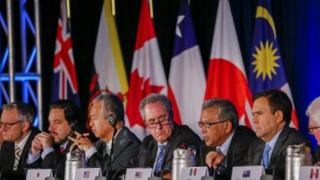 copyrighted image EPA
copyrighted image EPA kept his promise: the president of the united States, Donald Trump, withdrew the participation of their country in the trans-Pacific Economic partnership (TPP, for its acronym in English) just three days after assuming his charge.
this Is a great trade agreement multinational that today u.s. vice president Mike Pence supported when he was governor of Indiana, because he said that “trade means jobs, but it also means security”.
But during his campaign, Donald Trump is not tired of repeating the opposite, and this Monday by signing an executive order that establishes the withdrawal of his country’s covenant confirmed: “What we do is a great thing for american workers.”
what is the TPP and why it is opposed to him, the new president of the U.S.?
Integration vs. Protectionism
Even before the withdrawal of the US, the trade agreement TPP, covering close to 40% the world economy a market of some 800 million people.
Japan, Australia, Canada, Mexico, Peru, Chile, Malaysia, Vietnam, New Zealand, Singapore and Brunei are the nations that are maintained in the covenant.
largely absent among the economic powers of the Pacific continues to be China, which has not shown intentions of joining.
The agreement -of the government of the former president of USA Barack Obama had been a great promoter- lays the foundation for a superbloque economic, continue as is thought, will reduce the barriers to trade in the nations that participate in it.
Also harmonises the legislation on issues such as access to the internet, the protection of investors, intellectual property in areas such as pharmaceuticals and digital production, as well as in the rules of protection of the environment.
before his signing last year in Atlanta, U.S., the negotiations took five years in progress.
But that economic openness multinational, which raises it runs against the grain of the policy of protection which had been raised by Trump as his line of government.
The “protection” will be the foundation of the new “prosperity and strength” of EE.USA., said Trump in his inaugural address on January 20.
“we Must protect our borders from the ravages of other countries that manufacture our products, steal our businesses and destroy our jobs,” he said.
No China
The TPP is also considered as an integral part of the economic strategy of the three Latin american nations that are part of the agreement.
Chile was the pioneer of the region in search for commercial societies different to the traditionally oriented to the united States and Europe.
it Was, even, one of the four founder members of the agreement precursor to the TPP, along with Brunei, New Zealand and Singapore.
Mexico and Peru are also looking for increase their exports and attract significant investment from asian countries.
Among the nations of the Pacific Basin, however, the absence more noticeable in the TPP is the of China, the largest economy in Asia and the second largest in the world.
Other rejections
But the opposition not only comes from the new u.s. government.
critics of the initiative, allege that it was negotiated in secret and that primarily benefit multinational corporations.
The final round of agreements was delayed by disputes over the protection of intellectual property granted to drugs of last generation.
As is often the case in all the discussions around the free trade treaties, in the different countries put forward interests that could be strengthened or affected by the TPP.
exporters of various nations are hopeful with business expansion that promises the agreement, giving them new markets.
In contrast, in the US, several unions argued that the agreement will help that more industrial jobs, well paid are transferred to countries where labour is cheaper, such as southeast Asia.
it Is a key issue in the objectives of the government of Trump: to avoid that the jobs leave your country.
it remains to be seen if the US exit from the agreement, it comes into force and in what way, since the rest of the countries lose one of their main incentives: a greater access to the u.s. market.
No comments:
Post a Comment